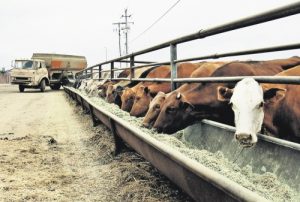In 1969, the Swann report recommended strict oversight and restrictions on the use of antibiotics used in human medicine as growth promoters in agriculture. That was in the UK, and 37 years later, the UK Food Standards Agency has published a systematic review of the available evidence on antimicrobial resistance (AMR) in food. The review looked at research on the presence of AMR in bacteria in a number of different foods sold at retail.
 The research has confirmed the need for extra surveillance of AMR in food at retail level, to support the wider programme of work currently underway across government to help reduce levels of AMR.
The research has confirmed the need for extra surveillance of AMR in food at retail level, to support the wider programme of work currently underway across government to help reduce levels of AMR.
The study was produced by the Royal Veterinary College, on behalf of the Food Standards Agency, and looked at the areas where consumers are more likely to be exposed to AMR in bacteria from the food chain. Researchers examined published evidence between 1999 and 2016 for pork and poultry meat, dairy products, seafood and fresh produce sold in shops.
FSA action includes:
Working to encourage the adoption of clear transparent reporting standards that help consumers have access to and understand information about the responsible use of antibiotics in the food chain.
Continued focus on improving the scientific evidence base relating to antimicrobial resistance in the food chain through supporting relevant research and improving surveillance.
Setting up an independent group to advise us on responsible use of antibiotics in agriculture to support the above work.
Background
Antimicrobial resistance (AMR) is a major public health issue worldwide. It is a complex issue driven by a variety of interconnected factors enabling microorganisms to withstand antimicrobial treatments to which they were once susceptible. The overuse and/or misuse of antibiotics has been linked to increasing the emergence and spread of microorganisms which are resistant to them, rendering treatment ineffective and posing a risk to public health.
People can become exposed to AMR bacteria through a number of routes such as human-to-human spread, animals, through the environment and food chain. There is currently uncertainty around the contribution food makes to the problem of AMR and the types of AMR bacteria found in foods on retail sale in the UK. There is a need to consider the literature in this area to gain a better understanding of the potential risk to consumers through contaminated foods and also to identify the key evidence gaps.
Research Approach
The aim of this study was to assess the prevalence of antimicrobial resistant bacteria in retail pork, poultry meat, dairy products, seafood and fresh produce that could pose a risk to UK consumers. For this purpose a systematic review was undertaken following the PRISMA guidelines (Liberati et al., 2009) through which current existing evidence present in scientific databases and grey literature is collected and assessed. A protocol, which describes the methodology used, has been made accessible through the International Prospective Register of Systematic Reviews (PROSPERO). The protocol is available at http://www.york.ac.uk/crd/. Please search PROSPERO using registration number CRD42016033082.
 Research questions were developed taking into consideration current evidence for relevant resistant foodborne pathogens and commensal bacteria observed in animals, food and humans in European countries published by the European Food Safety Authority (EFSA) (EFSA, 2015), feedback provided by experts and findings from scoping searches of the literature (i.e. PubMed).
Research questions were developed taking into consideration current evidence for relevant resistant foodborne pathogens and commensal bacteria observed in animals, food and humans in European countries published by the European Food Safety Authority (EFSA) (EFSA, 2015), feedback provided by experts and findings from scoping searches of the literature (i.e. PubMed).
Key recommendations:
There is a need to standardise the selection of antimicrobials for antimicrobial susceptibility testing panels, harmonising criteria for assessment of resistance per bacteria/drug combination for surveillance purposes, using a standardised definition for multidrug resistance (MDR) and the adoption of random sampling and adequate study design for epidemiological studies.
Identification of a core set of relevant antimicrobials when developing and implementing prospective testing for surveillance systems for determination of AMR in the food chain.
Surveillance priorities could be set using a risk-based approach, taking into account the importance of antimicrobials used for treatment in both humans and animals, and continued surveillance of the incidence and emerging resistance (including MDR) in commensal bacteria (Enterococcus spp. and E. coli) should be encouraged.
Data on AMR bacteria from British and imported pork meat in the UK are limited and dated. Further research and surveillance efforts are needed to ascertain AMR levels in both foodborne and commensal bacteria in pork meat in the UK.
There is evidence of increasing levels of resistance to antimicrobials in foodborne bacteria (i.e., Campylobacter spp.) from poultry meat in the UK. Research and surveillance efforts should be continued to monitor AMR trends in both foodborne and commensal bacteria in British and imported chicken and poultry meats in the UK.
There is a lack of information on AMR bacteria in foods of animal origin other than meat at retail level. In recent years, there have been growing numbers of outbreaks associated with milk and dairy products (cheese, butter, yogurt), seafood (fish and shellfish) and fresh produce (fruit, vegetables and salads) at national and international levels but there is scarce, scattered evidence of resistance and MDR occurrence in foodborne and commensal bacteria in these food products and its implications for public health. These gaps should be addressed also using a risk-based approach following evidence of resistance in food items as well as the extent of expected consumer exposure using consumption and import volumes.
Data on antimicrobial usage in food-producing animals in the UK are important to explain the occurrence and dynamics of AMR, resistance genes and MDR phenotypes in a defined geographical area. More complete information should therefore be collected on the type of production system from which food samples originate to assess the impact of animal husbandry practices as risk factors for resistance.
There is a need for more studies to quantify the contribution of both domestic and imported foods to AMR occurrence. Information on country of origin for imported products should be collected.
Priorities should be set according to the importance of a food item in terms of exposure of consumers. Consumption data will be essential for assessing the risk of exposure of British consumers.
Finally, further research and surveillance are needed to establish and quantify the risk of transmission of AMR against critically important antimicrobials in organisms from foods of animal and non-animal origin) to humans.
A systematic review of AMR bacteria in pork, poultry, dairy products, seafood and fresh produce at UK retail level
August 2015-October 2016
Food Standards Agency











